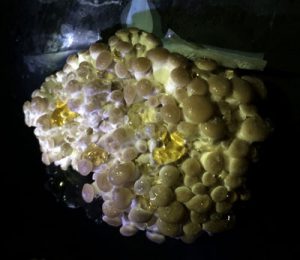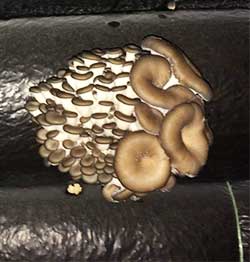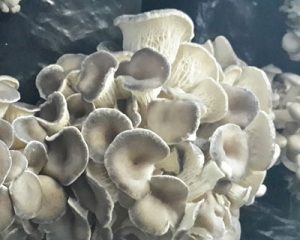Where does water come from in the substrate and on the small pins of oyster mushrooms?
This phenomenon is called condensation of water, and the water itself is called condensate.
There are many reasons for the formation of condensation, almost all of them are associated with microclimate disturbances at the incubation stage and in the growing chamber.
In the incubator, condensation is released between the substrate and the film.
If the temperature in the center of the block has risen, you want to quickly fix everything and lower the temperature in the substrate. To do this, you introduce very cold air into the incubator.
With a sharp change in the temperature of the incoming air, water is released from the substrate under the film.
Read more about how to get rid of this phenomenon in this article (section 2 Violation of the microclimate during incubation)
Condensation falls on the primordia if there are changes in humidity and temperature in the chamber.
Then some of the pins will die or grow with a delay.
And with a sharp change in humidity, the entire oyster mushroom will be wet - both adult mushrooms and developing growths.
If the temperature in the chamber drops even by 2-3 degrees, then the onset of the dew point (and therefore condensation on the mushrooms) is guaranteed!
But by the time you come to pick mushrooms, at about seven in the morning, there are no traces of condensation. Only the mushrooms are wetter than usual.
But the small primordia die. Sometimes they die in such an embryonic state that the slots remain empty. And you don’t even realize that mushrooms could have grown there if they had not died due to a thin film of water.
 Condensation on the primordia often appears as yellow or brown drops (the liquid is light yellow, visible in the photo).
Condensation on the primordia often appears as yellow or brown drops (the liquid is light yellow, visible in the photo).
Some mushroom growers think that it is the primordia themselves that secrete these drops.
But in fact, this is condensate in which substances from the substrate have begun to dissolve.
Therefore, it is extremely important that at the time of formation of primordia the ventilation system, humidifiers and heat exchangers operate without interruption.
If moisture condenses on the 2-4 cm mushroom cap, its surface may bend in an attempt to increase the surface area for moisture evaporation.
In the photo below you see such florid curvatures of the cap.

Sometimes condensation in the form of a thin film on the primordium is not even noticeable, but causes partial or complete death of small mushrooms.
After such an impact, the oyster mushroom primordia develop unevenly: part of the bunch stops (or slows down) development, and those primordia that emerged later and did not fall under the water film overtake them in growth.
If there is a large amount of unbound water in the substrate and high humidity of the subfilm layer, the formation of condensation on the primordia is also possible.
Mushrooms in a bunch may begin to grow in different directions if, during the formation of fruiting bodies, there was a constant humidity above 90% in the growing room
They have a thickened leg with a pronounced convex hymenophore (the area where the gills are located) - for the same reason that we discussed above - the impossibility of moisture evaporation.

Only in this case, the inability to evaporate moisture is not due to the low speed of air flow near the mushroom clusters, but to very high humidity.
With a humidity of 90-93%, there is a high probability of condensation forming even with the slightest temperature fluctuations.
This phenomenon can be observed even in fully automated chambers of oyster mushroom production complexes.
Therefore, as soon as the rudiments of primordia appear, the humidity must be reduced to the parameters for growing mushrooms, which are recommended by the spawn manufacturer for your strain.
In general, we can say that it needs to be reduced to 85-88%.
It depends on the strain and the room temperature
Review article on oyster mushroom diseases
